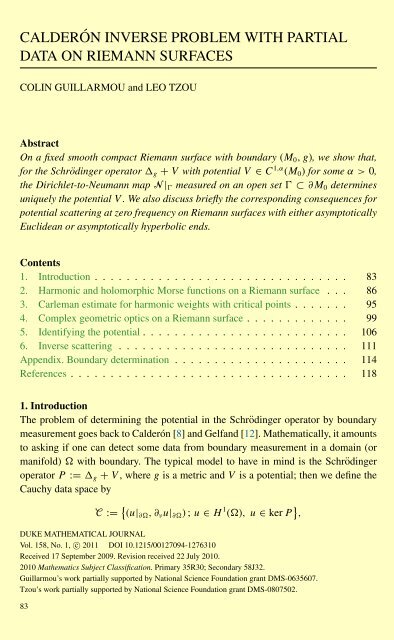NEAR OPTIMAL BOUNDS IN FREIMAN'S THEOREM
NEAR OPTIMAL BOUNDS IN FREIMAN'S THEOREM
NEAR OPTIMAL BOUNDS IN FREIMAN'S THEOREM
Create successful ePaper yourself
Turn your PDF publications into a flip-book with our unique Google optimized e-Paper software.
CALDERÓN <strong>IN</strong>VERSE PROBLEM WITH PARTIAL<br />
DATA ON RIEMANN SURFACES<br />
COL<strong>IN</strong> GUILLARMOU and LEO TZOU<br />
Abstract<br />
On a fixed smooth compact Riemann surface with boundary (M0,g), we show that,<br />
for the Schrödinger operator g + V with potential V ∈ C 1,α (M0) for some α>0,<br />
the Dirichlet-to-Neumann map N |Ɣ measured on an open set Ɣ ⊂ ∂M0 determines<br />
uniquely the potential V . We also discuss briefly the corresponding consequences for<br />
potential scattering at zero frequency on Riemann surfaces with either asymptotically<br />
Euclidean or asymptotically hyperbolic ends.<br />
Contents<br />
1. Introduction . . . . . . . . . . . . . . . . . . . . . . . . . . . . . . . . 83<br />
2. Harmonic and holomorphic Morse functions on a Riemann surface . . . 86<br />
3. Carleman estimate for harmonic weights with critical points . . . . . . . 95<br />
4. Complex geometric optics on a Riemann surface . . . . . . . . . . . . . 99<br />
5. Identifying the potential . . . . . . . . . . . . . . . . . . . . . . . . . . 106<br />
6. Inverse scattering . . . . . . . . . . . . . . . . . . . . . . . . . . . . . 111<br />
Appendix. Boundary determination . . . . . . . . . . . . . . . . . . . . . . 114<br />
References . . . . . . . . . . . . . . . . . . . . . . . . . . . . . . . . . . . 118<br />
1. Introduction<br />
The problem of determining the potential in the Schrödinger operator by boundary<br />
measurement goes back to Calderón [8]andGelfand[12]. Mathematically, it amounts<br />
to asking if one can detect some data from boundary measurement in a domain (or<br />
manifold) with boundary. The typical model to have in mind is the Schrödinger<br />
operator P := g + V , where g is a metric and V is a potential; then we define the<br />
Cauchy data space by<br />
C := (u|∂,∂νu|∂); u ∈ H 1 (), u∈ ker P ,<br />
DUKE MATHEMATICAL JOURNAL<br />
Vol. 158, No. 1, c○ 2011 DOI 10.1215/00127094-1276310<br />
Received 17 September 2009. Revision received 22 July 2010.<br />
2010 Mathematics Subject Classification. Primary 35R30; Secondary 58J32.<br />
Guillarmou’s work partially supported by National Science Foundation grant DMS-0635607.<br />
Tzou’s work partially supported by National Science Foundation grant DMS-0807502.<br />
83

















